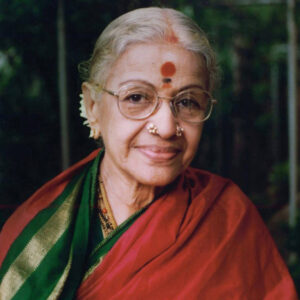How to Help Your Child Appreciate Carnatic Music – A Personal Reflection
“செவியிற் சுவையுணரா வாயுணர்வின் மாக்கள்
அவியினும் வாழினும் என்.”
– Thiruvalluvar
(“What is the purpose of living when one can taste through one’s mouths but not ears?!”)
Children who grow up in western countries (and even Indian cities) are exposed to several genres of music. While there is no such thing as a good or a bad genre, some are more of an acquired taste than the others. This note reflects on what it takes for a child to develop an ear for Carnatic music, which is ‘harder’ to appreciate than most other kinds of music.
I grew up in the Kaveri delta, where the Carnatic trinity was born and created their compositions. Music was all around me, in temples, radio, and festivals. Like a fish unaware of the water surrounding it, I was unaware of the music surrounding me. Specifically, Carnatic music.
It was worse than that. There was an incident that made my family probably give up on me regarding music. For a school project, I made a hand-wound gramophone record player. I was looking for some records to test my new contraption. I raided my uncle’s record collection and picked a few that looked disposable. Those were by two gentlemen named Madurai Mani Iyer and G N Balasubramayam. My new record player and its operator, not being very precise, scratched the records beyond repair. When the news broke, my family was very disappointed, first for the lost treasures and then for my seeming lack of musical taste. So, it was safe to say, they weren’t holding their collective breaths for me to develop into a music connoisseur.
As I was growing up, I had listened to plenty of Carnatic music at home and in temples, weddings, etc. I didn’t exactly hate such music when I heard, but I didn’t know what the fuss was either. When we lived in Tiruvarur, I used to accompany my grandma when she went to listen to the open air concerts by greats such as Smt. M.S. Subbalakshmi and Smt. M L Vasanthakumari. I was the designated male “bodyguard”, although I must have been only 10 or 11. During the concerts, I amused myself by watching the lighting, the crowds, and the artwork on the chariot. I don’t recall ever paying attention to what was happening in the concerts.

My cousin learned from an accomplished vidwan. Swamimalai Sri Janakiraman used to come home to teach her. I recall his visits; I recall that she had a good voice; but don’t remember ever sitting down to listen to them. I can now remember some of the songs she learned, which means some have been registering in my subconscious mind.
As I entered my teens, I learnt the song ‘Samaja Varagamana’ as it was rendered in the Telugu movie Sankarabharanam on my own. I was told that the song was in the raga Hindolam. I surprised myself by identifying that raga when someone sang or played it. But that was the extent of my skill – I could tell whether a song or alapana was Hindolam! I had no aspiration to improve my repertoire. I still didn’t have the patience to listen to anyone singing Hindolam for any prolonged period.
Years later, when I was in my late teens, Maharajapuram Sri. Santhanam had agreed to sing on the eve of my cousin’s wedding – a different cousin. The concert was held in a small hall for a select audience. I was there by being a member of the family. I wasn’t particularly apprehensive, but I wasn’t looking forward to sitting for a prolonged period in a small hall, where the audience was small enough that the artists could make eye contact. The concert started, and it somehow pulled me in. As it progressed, I was enthralled.
No, he didn’t sing Hindolam. The main ragam was Saveri, although I didn’t know it then. While I didn’t know what the raga was called, I could associate it with the start of ‘Bhavayami Raghuramam’. As he sang Ragam-thanam-pallavi, I tried to predict the following note, phrase and line he would sing. That was a new experience. For the first time in my life, I began to appreciate why people spend hours listening to such seemingly repetitive, old-fashioned music.
As I spoke to more knowledgeable folks, I realized that all the passive listening in my earlier years had prepared me for the appreciation of music that evening. It took a great artist, and a focused listening session to bring the knowledge to the foreground.
Soon after, the society to promote Indian classical arts, SPIC-MACAY, arranged a violin concert by Lalgudi Sri Jayaraman in my college. I listened to it, and was spellbound again. Over the next few years, I sought out opportunities to hear these two great artists in person and recordings. Years later, if someone sings or plays in their paani, it still appeals to me.
All this is not to say that I’ve developed into some authority in music now. However, I have indeed developed musical tastes, likes, and dislikes for this style of music. I try not to miss the concerts that occur in Toronto. The unique combination of art and science that forms Carnatic music provides me great pleasure, although it took years for me to be receptive to such music.
When it comes to educating children, the best thing the parents can do is expose them to plenty of passive listening. Children growing up in countries like Canada won’t have anywhere near the extent of involuntary exposure to music that I (and most people from my background) enjoyed. But that can be partly compensated by playing an album a day at home or in the car that the kids listen to, even if it’s just background ‘noise’ for them. Pick good music, without compromises.
Not every child will grow up liking Carnatic music, or music. That’s ok. The parents’ job is to provide the opportunity for the children to discover their interests, and provide adequate background material for the interest to blossom, if and when it does.
Notes do not just learn many songs and ragas. Learning how you bend the notes and oscillate them (gamakas) and which parts are emphasized (raga lakshana) requires plenty of listening. My experience has taught me that you train your ears with years’ worth of such listening without even being conscious. While the parents are keen to enroll the kids in music lessons, they may also want to consider giving their children the advantage of trained ears.
One more point before we wrap up. It’s also essential to have a circle of reinforcement. Children, especially young ones, look at something as not-so-cool if none of his/her friends do that. This applies especially to classical arts. So it is helpful to build a social circle with the other children who are also learning.
How Parents Can Help Kids Appreciate Carnatic Music:
- Play Carnatic music at home and in the car regularly.
- Choose high-quality renditions by renowned artists.
- Encourage children to attend live concerts when possible.
- Help them find a peer group who also learn Carnatic music.
- Be patient—appreciation may take years to develop.
Have you or your child had a similar experience with learning to appreciate Carnatic music? What worked for you? Share your thoughts in the comments!



